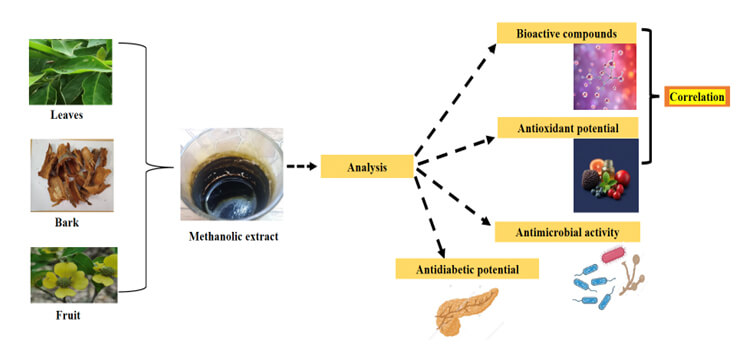 Open Access
Open Access
ARTICLE
Orchestrating the Phytochemical Content and Bioactivities in the Leaf, Bark, and Fruit Extracts of Cornus capitata Wall
1 Department of Biochemistry, Hemvati Nandan Bahuguna Garhwal University, Srinagar Garhwal, Uttarakhand, 246174, India
2 Department of Biomedical, Surgical and Dental Sciences, University of Milan, via L. Vanvitelli 32, Milan, 20129, Italy
3 National Interuniversity Consortium of Materials Science and Technology, via G. Giusti 9, Firenze, 50121, Italy
4 Cosmetics and Natural Products Research Center (CosNat), Faculty of Pharmaceutical Sciences, Naresuan University, Phitsanulok, 65000, Thailand
* Corresponding Authors: Manisha Nigam. Email: ; Marcello Iriti. Email:
(This article belongs to the Special Issue: Advances in Molecular Insights of Plant Secondary Metabolites: Biosynthesis, Regulation, and Applications)
Phyton-International Journal of Experimental Botany 2025, 94(3), 1007-1027. https://doi.org/10.32604/phyton.2025.061270
Received 20 November 2024; Accepted 24 January 2024; Issue published 31 March 2025
Abstract
Cornus capitata, commonly known as the Himalayan strawberry, is a dogwood species from the family Cornaceae. Dogwood plants have been used extensively to practice conventional medicine due to their biological activities; however, the mechanisms behind these activities, particularly in C. capitata, remain largely unexplored. This study focuses on the preliminary phytochemical screening, antioxidant activity, anti-diabetic potential, and antimicrobial profiling of different extracts (i.e., leaves, bark, and fruit) from C. capitata to evaluate its potential pharmaceutical and medicinal applications. The in-vitro antioxidant activity was evaluated using 1,1-diphenyl-2-picrylhydrazyl (DPPH) scavenging assay, Ferric-reducing antioxidant power (FRAP) assay, and Superoxide Anion Scavenging assay. The anti-diabetic potential was assessed using α-Glucosidase, α-Amylase, and Pancreatic lipase inhibition assay. The anti-microbial activity was evaluated using the Kirby-Bauer method and Minimal Inhibitory Concentration (MIC). According to the quantitative investigation, the most substantial quantities of flavonoids and phenolic compounds were identified in the leaves of C. capitata. Antioxidant activity results corroborated this conclusion, demonstrating that methanolic leaf extract had strong antioxidant activity, with the lowest IC50 values recorded for the DPPH (32.4 ± 0.19 µg/mL) and Superoxide Radical Scavenging (37.10 ± 0.21 µg/mL) assays. Furthermore, the methanolic leaf extract displayed the highest α-Glucosidase inhibitory potential (IC50 = 6.09 ± 0.52 µg/mL), while the methanolic bark extract exhibited the highest α-Amylase inhibitory activity (IC50 = 49.10 ± 0.38 µg/mL). Regarding antimicrobial potential, the paper disc diffusion assay showed that none of the extracts demonstrated antibacterial effects against E. coli. However, the MIC assay revealed that the leaves and bark extracts exhibited antibacterial properties with MIC values of 80 and 500 µg/mL against E. coli, respectively. The paper disc diffusion assay against C. albicans indicated the antimicrobial potency of all three extracts. The crude methanolic extract of C. capitata shows strong antioxidant and antidiabetic potential, highlighting its therapeutic value. This is the first comparative investigation of leaf, bark, and fruit extracts of C. capitata to orchestrate the phytochemical profile and evaluate the antioxidant, antidiabetic, and antimicrobial activities. Nevertheless, further studies are needed to understand its biological implications.Graphic Abstract

Keywords
Cite This Article
 Copyright © 2025 The Author(s). Published by Tech Science Press.
Copyright © 2025 The Author(s). Published by Tech Science Press.This work is licensed under a Creative Commons Attribution 4.0 International License , which permits unrestricted use, distribution, and reproduction in any medium, provided the original work is properly cited.


 Submit a Paper
Submit a Paper Propose a Special lssue
Propose a Special lssue View Full Text
View Full Text Download PDF
Download PDF Downloads
Downloads
 Citation Tools
Citation Tools